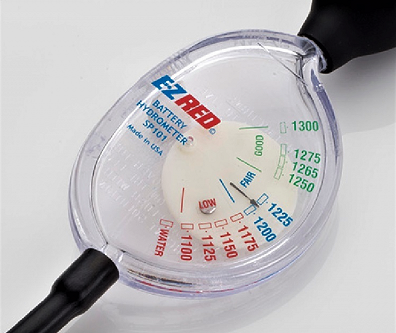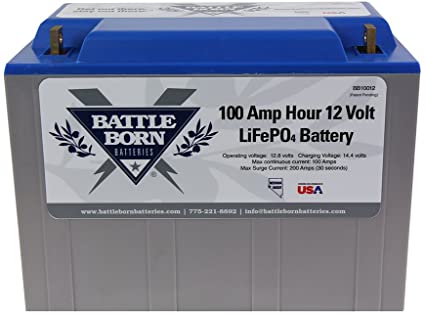How To Properly Charge A Deep Cycle Battery
DISCLAIMER: AS AN AMAZON ASSOCIATE I EARN FROM QUALIFYING PURCHASES. THIS POST CONTAINS AFFILIATE LINKS THAT WILL REWARD ME MONETARILY OR OTHERWISE WHEN YOU USE THEM TO MAKE QUALIFYING PURCHASES. FOR MORE INFORMATION, PLEASE READ MY EARNINGS DISCLAIMER.
|
Selecting the right charger is the basis of charging your deep cycle battery correctly. The reason for this is that, unlike a standard battery, a deep cycle battery is designed to reach a significant depth of discharge (up to 80%).
Deep cycle batteries are also known for providing more power for longer periods of time and the ability to withstand many deep discharging/recharging cycles. They need to be charged in distinct phases in order to last longer and charge faster.
This type of battery is very different from car cranking batteries (AKA “starting battery”) and if not charged correctly, you will not get the maximum performance intended for those batteries and may end up with unexpected problems. Cranking or starting batteries have one primary purpose – “to turn on your car or boat’s motor” and they do not discharge to the level of deep cycle batteries!
Regular cranking batteries are NOT designed to run anything else on your boat or RV (like a refrigerator or A/C, for example). They are designed to give you a quick energy boost in order to start your engine, in comparison to deep cycle batteries which provide low to moderate current to run your appliances for quite a while.
The reason behind charging a deep cycle battery in phases and NOT continually at a high amp level is that you do not want to overcharge it and generate heat along the way (which is bad for the battery itself and could be a fire hazard).
The slower the deep cycle battery will be charged, the better. If you go with low cost, “no-name manufacturer”, you may end up with a problem on your hands like overcharging and overheating.
Battery charging from a reputable manufacturer will take place in stages. The closer the battery charge gets to its full capacity, the fewer amps will be supplied to it by a charger.
“Using incorrect charger or charging method may shorten the lifespan of your batteries.”
Do NOT get a charger that is suitable for a car battery, you need the one that will charge the deep cycle battery correctly! Here is a plan to follow in order to ensure that your battery will be charged properly:
- Get the right charger.
- Follow the charging steps.
- Let it rest (cool off period) after charging.
Which charger is appropriate for a deep cycle battery?
There are basically two types of chargers that are generally used to charge batteries:
- Trickle charger. Also known as a “float charger”. This type of charger will NOT be able to charge you a deep cycle battery, because its main purpose is to keep your battery “topped off” when it’s not being used. Although you can charge regular batteries with them.
- Deep-Cycle Charger. This is a special charger that is designed specifically for deep-cycle batteries. It charges a battery in phases and protects it against overcharging. Charging starts at a higher amps load and as soon as it detects about 80% of charge, the amp load will become less, at 90% even less, and so on.
As soon as the battery is almost full, a deep cycle charger will start acting like a trickle charger (also known as a pulse-charger) and will start sending short chargers to the battery to keep it topped off.
** Important note! Trickle chargers DO NOT vary in how much voltage they will output. Even if your charge is at 95%, they will give you a full burst of current anyway. This may lead to possible overcharging of your deep cycle battery and battery damage.
Besides using a charger that takes AC current from utilities, you can also charge them off the motor’s alternator or with collected solar power (here are some examples):
- Solar Charge controller. If you are using solar panels on your RV or boat, you may want to consider this type of device to charge your deep cycle batteries. This controller ensures that your battery will not be overcharged during the day and completely drained overnight. Here is a nice charge controller from Victron (paid link), which is sold on Amazon. For those who read my posts, you probably noticed that I am a big Victron fan 😊!
- DC Alternator onboard charger. This is charger takes voltage from the engine’s alternator to charge your deep cycle battery while your motor is working. Here is one, sold on Amazon from MinnKota (paid link).
Regardless of the type of charger, you decide to use, (alternator regulator, solar charge controller, taffrail generator, or regular utility power converter, etc.), just make sure that charging will be done in stages by a good quality efficient charge device.
- Bulk stage. This is where the majority of work is done to about 80% of full capacity. Voltage increases slowly.
- Absorption stage. Charger applies reduced current until the battery reaches 90-95% of its capacity.
- Maintenance stage. The current level is reduced even more. The charger will trickle and top your battery off to 100% as needed.
Here are charging recommendations by US Battery.
Different types of deep cycle batteries can withstand different charging phase cycles. Make sure your charger is designed for your particular battery type!
Usually, a good battery charger will supply you with this information or be able to charge all three types as long as you select the right setting (Flooded, AGM, or Gel) for your deep cycle battery.
Selecting the right size charger! This generally depends on your battery size, type of battery, and whether you have a continuous AC power source. If you spend most of your time hooked up to the shore power, then you need a smaller charger.
If you have an intermittent AC power supply, then a bigger charger should charge your battery faster, since you have limited time to do it. One thing you should be aware of is that different types of batteries accept different maxim amperage:
- Flooded (or wet) type batteries. This type of deep cycle battery can be charged at a maximum rate of up to 25% of its capacity. Temperature-compensated charging is highly advised.
- Gel batteries. This type of battery chemistry will accept a maximum amperage of as much as 30% of its capacity. It also requires temperature compensated charging.
- AGM batteries. This type of battery will accept the highest amount of maximum amps to about 40% of its capacity. It also requires temperature compensated charging.
Even though most battery charges have a special program for each battery time, there are some manual versions that will let you set your own value.
Prior to charging, don’t forget to select an appropriate program for YOUR type of battery (Gel, AGM, Flooded). Battery charge time will generally depend on the size of the battery you are using, how many amps your charger is giving you, and how discharged is your battery.
What is temperature compensated charging? If your location temperature is below 77°F ( or 25°C), you need to raise your voltage setting, if above the same exact temperature, then you should lower your voltages.
** Warning! Do not charge a battery that is frozen and at temperatures above 122°F (or 50°C).
** You may want to know! If you wonder if your AGM battery is a deep cycle battery, it may or may not be. Deep cycle batteries can be AGM (a special type of lead-acid battery), but not ALL AGM batteries are deep-cycle.
How to charge a deep cycle battery properly
Here are the steps to take for your battery charge and maintenance:
- Initial charging.
- Charging itself.
- Maintenance stage.
Do NOT fully discharge before charging! There is no need to discharge your lead-acid batteries (AGM, Gel, or Flooded/Wet) before charging them again.
Initial charging. When you get your brand new deep cycle battery, there is a big possibility that your battery is somewhat discharged and you need to give it a boost. It is ALWAYS recommended by many manufacturers to give a battery a full charge before the first use.
Charging steps. Before getting started, move your battery to a well-ventilated place. If your battery has been sitting for a while, it may require some cleaning.
Remove any corrosion and acid buildup around the terminals by using baking soda and water solution (one tablespoon for each cup of water. If the corrosion is really bad, you may need to use sandpaper to get it out.
The proper way to charge a flooded battery
Here is a step-by-step process for charging flooded batteries:
Step#1. Check electrolyte level
If your plates are not fully covered with electrolyte add some distilled or de-ionized water before you start charging. You can check the electrolyte level of your battery by using a hydrometer and if it reads anything else but “good”, your water level is low.
This device actually checks the acidity level of your battery.

Step#2. Check vent caps
Don’t forget to recap your cells after the previous step. They should be in place and secured.
Step #3. Make sure you are charging the right battery
In our case it’s a “flooded” battery, so select an appropriate battery setting and its voltage (6, 12, or 24 volts) on your charger.
If you have a manual version of the charger, put your deep cycle battery on the slowest mode you can get away with (depending on how many available hours you have on land or in the RV camp). If you need to charge faster, set it to 20% of the amp per hour rate (it should be written on the battery).

Step#4. Connect the battery
There are right and wrong ways to connect the battery. Positive cable (+) connects to the positive terminal (+), negative cable (-) to the negative terminal (-). Anything other than that will not work (usually everything is color-coded, so should be easy).
Step#5. Start charging
Turn your charger ON and give it 20 min to get your actual charge reading. If your charger has a voltage regulator, then once the battery is fully charged, it will stop charging. If it does not, you will need to monitor the battery charge (on an hourly basis) and disconnect it, when it’s done.
** Warning! When checking the electrolyte level of your battery make sure you put rubber gloves on and a set of goggles in case the acid splashes out of the cell.
How to charge AGM and Gel batteries
Same steps as in Flooded batteries, except for checking electrolyte levels, since the batteries are sealed and are claimed to be “truly maintenance-free.” They require NO additional water.
If you are still not sure how to properly charge your deep cycle batteries, you can simply do this:
** Very important! After each use (30 min or more), charge your battery to its full capacity. To avoid self-discharge of your deep cycle battery, use float (or trickle) charging.
“Overcharging and undercharging can significantly reduce battery life and lead to poor battery performance.”
Cooling deep cycle battery off after charging
When your battery is finally charged, it is recommended that you give it a “cooling off” period before plunging it in your RV, boat, golf cart, etc. The reason for this is that battery builds up the heat while charging and you need to give it several minutes to cool down before starting to use it again.
If you don’t, it may wear out really quickly and become useless. This only applies to deep cycle batteries, since they have a longer charging period and higher amp capacity than the regular ones.
Deep cycle batteries are prone to reaching high internal temperatures and this is where a good battery charger comes in. As a safety feature, if the battery gets too hot while charging, the charger will stop charging it in order to avoid further complications.

Click on the white button above to find your electrician!





Marine and AGM start batteries must be charged at lower currents than wet cell batteries which can be a problem in a car or truck especially if the battery is allowed to discharge below 50% charge.
And maximum charge current should be below 15amps.
And the higher charge voltage of a car or truck alternator in cold temperatures will also shorten the life of AGM batteries.
Old school wet cell batteries unlike AGM batteries are designed for high current discharge and high current charge so they are still ideal for start batteries.